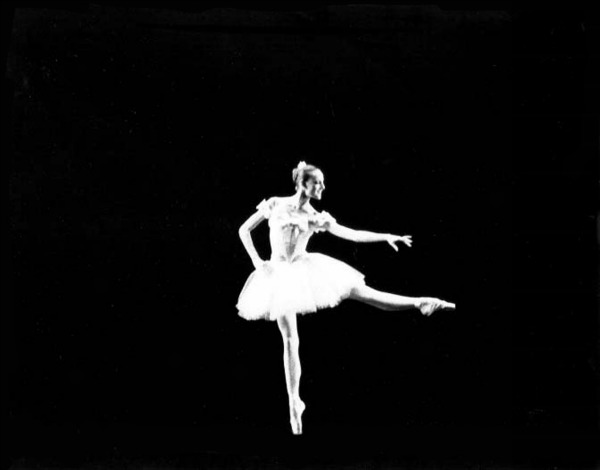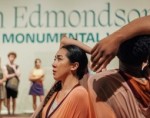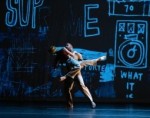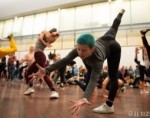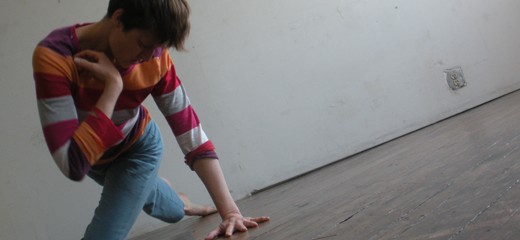
Photo: Michelle Tantoco
Steering In Interesting Water -- An Interview with Asimina Chremos
by P. Graham
I’ve always counted on Asimina Chremos to be fresh and daring, to be thoughtful and thought-provoking and, attentive cultural warrior that she is, to be in the forefront as a dance artist. Much of her early work, done in Philly in the ‘90s, stands out vividly to me still. In memories of the piece, Bridle
, her “bride” is a white, hoop-skirted ghost in my head, repeating her gestures to softly distant clanking. The source of the bride’s soundtrack is unveiled at the end when Chremos, virtuosic in the role, lifts the hoop to reveal a round of suspended pots and utensils — the hardware that girds her. Many works featured her remarkable self-designed costumes that immediately revealed and commented, with humor and vivid style, on women. Although she came to us as a ballerina-turned-modern auteur, I don’t recall her spending a lot of time referencing that first language, but I do remember a looping deconstruction of ballet conventions in which she worked in, outside of and around the technique, with wide sinking pliés and oblique body angles, revealing the finely expressive details of her back and skewing the expected balletic self-display.
P. Graham: On hearing that you created a new solo, Perfect Power, that bounces off the image of you as a young ballet dancer, it seemed a wonderful excuse to get together and ask some questions about that and your current artistic process, how it has evolved and where you are now. I know you worked for the Pew Center for Arts & Heritage these last three years and now you’re back to full time art making.
Asimina Chremos: I’m excited. I’m so happy to be back in my artist’s boots, in my dance pants.
PG: I remember your early work as vibrant with your own witty costumes. Your characters and theatricality often had layers of social commentary. What I’ve seen of you lately is very physical improvisation, with sparse live musical collaborations. All of it seems centered in the pure immediacy of your body. What’s the arc of how you got from there to here?
AC: I left Philadelphia in November ‘96 and when I got to Chicago I found myself in a completely different cultural landscape. I tried for a while to be a choreographer and I had a pick-up company. I did some group choreography and just found that I was not that good at it. I’m much stronger as a soloist, when I don’t have to try to transmit my ideas to other bodies that haven’t had the same life or training that I’ve had. I also noticed that people in the Midwest are a lot less neurotic than people on the East Coast. When I would work here with dancers and I would say something like, “lift your arm slowly,” people would do it in a super dramatic way. I was always so surprised at the Midwestern young women that I worked with! They would just raise their arm and there was no drama or inner angst at all. I found that the way that I was working in Philly just didn’t transmit as well. I did do this thing called the Ladylike Performance festival for a few years in Chicago as well, where I was exploring my interest in femininity as drag. That had been a big part of my work here in Philly.
That faded away as I started to learn about the improvised music scene in Chicago, which is really great and there’s a lot of amazing musicians there. I studied the history of improvised music and the use of graphic scores in the ‘60s. Also, I just started to appreciate the space. The Midwest has space. The streets are broad and it’s flat. People’s apartments have space in them. So this kind of psychodrama influence from Philadelphia – I don’t know what’s going on here but there’s a really strong influence of dramatic, theatrical types of impulses that a lot of artists seem to follow – in Chicago that dropped away and I started understanding improvisation in this context of open space that wasn’t filled with all this drama of entertaining neurosis. I dropped my company and just started improvising more and more – it’s been a very, very gradual change and here I am fifteen years later and I only practice improvisation.
PG: You grew up a disciplined ballet student. What place does taking or teaching classes have in your life now?
AC: I became more and more uncomfortable with the whole notion of teaching dance technique to people and trying to take dance technique classes. I think some of the inquiries that I had started years and years ago when I realized that I wasn’t ideologically in harmony with all the ballet training that I’d done, some of that inquiry came back up again. This whole idea of telling people what to do with their bodies and going to take a dance class where I’m listening to someone else tell me what to do with my body and judging how well or not I did it – it became very difficult to me. Not only did I not have any interest in it, when I tried to put myself into those situations I became very upset. So I have really found being an improviser to be super liberating and pleasurable and infinitely interesting and a seemingly inexhaustible kind of path.
Whatever practice we’re doing should increase our sensitivity and not decrease it. I don’t think that ballet or any other technique means to desensitize you. I don’t mean to vilify learning of any particular technique. The techniques themselves are embodied value systems and they can carry ideological baggage. We need to be aware of that. I think ballet is really interesting. There are a lot of things in it that require you to become tough and strong.
PG: The key quality in improvisation is the improviser’s presence each moment. You gave a great explication of this in your review for Title Magazine: “In facing the empty space and time of an improvisational performance, the artist needs technical chops that come with training and practice and the awareness and acceptance of the moment…. When technique and awareness converge, flying and falling are the same thing. Searching loses its aimless fear and becomes unfolding.” Brava on the writing. How can a dancer develop the technique to hold the space in this way?
AC: I think the practice is to find an open space, find an open time, and move around (laughter). So, that’s it —just doing that many, many times and things come up. We bring our histories with us, we bring our ideas with us and we bring our judgments with us. I feel like just by continuing to practice we notice those things. If we notice I did that move and I hated it, it’s gone and you’re on to the next thing. “I feel like right now I should be more stiff and less swishy,” so you do that and then you see what it’s like. I think the only practice is just doing it and noticing what comes up and not worrying too much about it. But also realize that it’s also going to really feel terrible some times. I feel like it’s a really good practice for life. Although a lot of times I realize it’s better, a lot simpler, because I work as a solo artist.
PG: It seems to me there’s more improv going on now with young dancers in this town than in times past. This is asking for a bit of generalization, but can you comment on what you’ve been seeing?
AC: I think the improvisational form has pitfalls, especially when people are working in groups. I don’t see that people have worked a lot on improvisation on their own, to develop their own “stance,” so when they enter into a group they haven’t developed a mature approach. It’s really about the level of exploration. Sometimes it doesn’t feel to me like the artist is re-entering an established practice. It feels like artists are doing something that’s fun, that allows them to know themselves better as artists, or maybe do a performance without a huge investment up front of time and expense. Those are great things about improvisation. It is really low budget. Somewhere in there I feel that the solo practice and preparation are really important and I don’t know that a lot of people are committed to that.
PG: Getting back to your recent solo, Perfect Power, what was the impetus for the piece?
AC: There was a photo circulating of me on Facebook, from when I was about 17, as a professional ballet dancer with Pittsburgh Ballet Theater. People love this picture and it’s gotten more comments than anything else I’ve done. It gives me a lot of mixed feelings because I think a lot of suffering went into that image and the things that I’ve done since then have been so much more courageous and creative but are less comprehensible to people. That was actually the impetus for that piece.
PG: Do you have any long-term vision of where you want to go as an artist?
AC: My long-term vision is to be getting better in terms of intuition and steering my boat in interesting water.
By Patricia Graham
May 14, 2014

